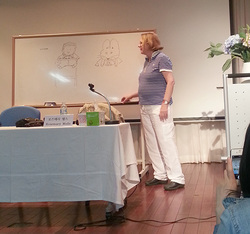 I ventured out on the subway to Seoul for my VERY first time to hear Rosemary Wells speak to picture book writers/illustrators. This was also my very first writing meeting to attend here. My kids and I are familiar with her famed Max and Ruby characters, and as a teacher I had some of her other books. (I did get an autograph.) Rosemary is on a tour in Asia, speaking at many international schools. She's headed to Japan next. My job is to have ideas. ~ Rosemary Wells  Rosemary spoke to the audience through a translator since the 100 attendees were Korean writers, illustrators, and design students. We met at a library by one of the ancient palaces. Somewhere in my MRI brain is a kitchen sieve and all the ideas go into the colander, but most go out. But once in a while, one sticks! ~ Rosemary Wells  Her lecture's theme was how she turned her ideas into picture books. Where do you get your ideas? RW: From my life, everything I see, hear, know, and live through. You never know when something happens and it'll be the beginning of a book. Here's the story behind Yoko: Her daughter came home from 1st grade and told her mom that three Japanese girls were in her class. (Mitsubishi was in the next town.) Every day their mom made lunches in bento boxes. The American kids made fun of them. "Raw fish! Seaweed! Yuck!" The Japanese girls just laughed and started talking in Japanese. They didn't care. So in Rosemary's writer's head, she took this idea and changed it. She chose only ONE girl who faced a problem of children universally: Kids are cruel and highly rigid. She had Yoko tell her mother that she didn't want to go back to school. As a writer, she now had a subject. The mother tried to help but failed. The teacher tried to help but failed. She pushed Yoko through until she was about to break down. Spoiler alert: In the end, Yoko made a friend who liked sushi, and they opened a restaurant of vanilla ice cream, sushi, red bean ice cream, and spaghetti. This book is about two powers--cruelty and friendship.  Here's another example how she used a real-life experience and turned it into a picture book. One rainy night her husband went to the store but came home without milk. It wasn't on the list. So Rosemary went out, and the store was about to close. As she grabbed milk and got in line, the lady in front of her had like 365 items. And she wouldn't let Rosemary go through with her one item of milk. Frustrated, Rosemary waited. In front of her sat a three-year-old boy who was not happy. He glared at Rosemary. On his shirt was a vampire with two eyes that also glared. She forgot about the incident until the following week at 5am (when Rosemary does a lot of her best thinking). But in her head, the boy was a bunny--MAX! Her idea: Max wants a dragon shirt. And this became the beginning of her book, Max's Dragon Shirt.  original art featured at nearby museum original art featured at nearby museum Wisdom from Rosemary Wells: Characters: The character is the heart of the emotional story. Make sure your character is real in very few words. In the first two pages, tell what your character is about. Theme: She said that it's a mistake to write about themes. You can't write about adult themes. For examples, if your book is about a peanut allergy, then the allergy becomes the character, not the girl in the book. Keep your eye on the main character rather than the theme. Word count: Keep your text short. No more than 4 lines on a page. Use precise writing. Structure: Keep the story in 12 double page spreads. Make a storyboard. Add page numbers and write the action down to see the story all at once. Ending: Unless you know how it's going to end, you can't write the story. She doesn't like happy endings. They tie up strings and are formulaic. Instead, she likes funny endings. They're unexpected and make your readers laugh. Writing is like looking at a tunnel. You need a light at the end so you know where you're going. Otherwise, you're walking blind. ~ Rosemary Wells  Lastly, I must thank my new writing friend, Junghee, for escorting me to this wonderful event. Without her, I would've been completely lost on all the train connections. This is her cat. She wouldn't let me show her photo. Even though we had language difficulties, we could communicate using Google Translator. You can check out Junghee's wonderful embroidery illustrations.
36 Comments
|
Tina M. Cho, children's authorI'm a children's author and freelance writer for the educational market. Welcome! Archives
March 2024
Categories
All
|




 RSS Feed
RSS Feed
